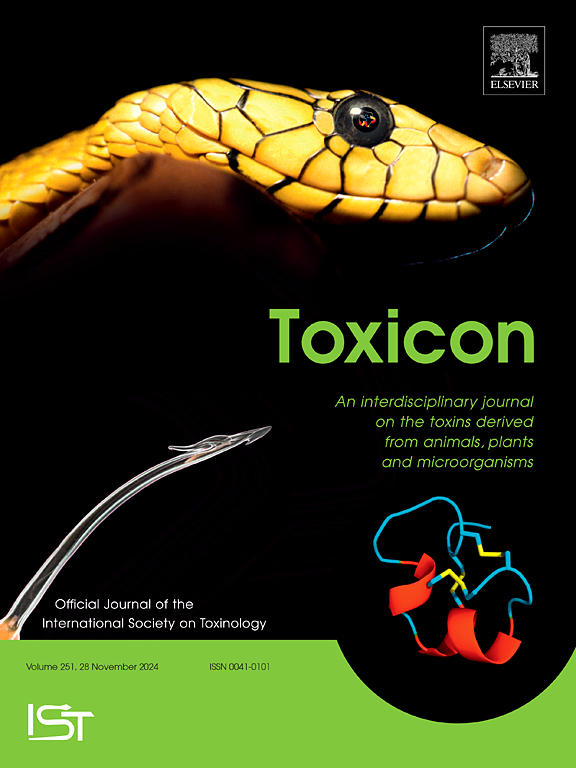Toxins under a Rock: Proteo-transcriptomic analysis reveals the venom composition of the Pseudoscorpion Ammogarypus lawrencei (Pseudoscorpiones: Garypidae)
IF 2.6
4区 医学
Q2 PHARMACOLOGY & PHARMACY
引用次数: 0
Abstract
Pseudoscorpions represent one of the venomous animal groups least investigated with respect to their venom composition. So far, the venom of only a few species of these tiny arachnids has been analyzed, among which only the cosmopolitan species Chelifer cancroides and the Australian Synsphyronus apimelus have been investigated in more detail. Here, we advance the current understanding on pseudoscorpion toxins by unveiling the venom composition of the African species Ammogarypus lawrencei via proteo-transcriptomics-guided venomics. Belonging to the same family as S. apimelus whose venom was analyzed solely by a transcriptomic approach, we found the highest similarities between putative venom compounds in these species. Instead of an enzyme-rich venom predicted for S. apimelus, we found the venom of A. lawrencei to be dominated by Cysteine-rich peptides (CRPs). Many of these peptides show moderate similarity to neurotoxins found primarily in other arachnids, although a large proportion could not be annotated in more detail due to their high sequence disparity. Enzymes are a minor component in the venom of A. lawrencei and classified mostly as peptidases and triacylglycerol lipases, likely fulfilling a predigestive function or acting as spreading factors. Lastly, we identified a range of linear and putatively antimicrobial peptides in the A. lawrencei venom, which seem to be unrelated to the previously identified checacin-type linear peptides identified in the venom of C. cancroides. Our study provides valuable insights into the molecular diversity encoded in pseudoscorpion venom glands and identifies a range of novel biomolecules with putative translational potential.
岩石下的毒素:蛋白质转录组学分析揭示了假蝎子Ammogarypus lawrencei的毒液成分(假蝎子:Garypidae)。
假蝎子是对其毒液成分调查最少的有毒动物群体之一。到目前为止,对这些微小的蛛形纲动物的毒液进行了分析的只有少数几种,其中对世界分布的物种Chelifer cancroides和澳大利亚的Synsphyronus apimelus进行了较详细的研究。在这里,我们通过蛋白质转录组学指导的毒液组学揭示了非洲物种Ammogarypus lawrencei的毒液组成,从而推进了目前对假蝎子毒素的理解。与S. apimelus属于同一科,其毒液仅通过转录组学方法进行分析,我们发现这些物种中假定的毒液化合物之间的相似性最高。与预测的S. apimelus富含酶的毒液不同,我们发现A. lawrencei的毒液主要由富含半胱氨酸的肽(CRPs)组成。这些多肽中有许多与主要存在于其他蛛形纲动物中的神经毒素表现出适度的相似性,尽管由于它们的高度序列差异,很大一部分无法更详细地注释。酶是a . lawrencei毒液中的一个次要成分,主要分为肽酶和三酰甘油脂肪酶,可能具有消化前功能或作为扩散因子。最后,我们在a . lawrencei毒液中鉴定了一系列线性和推定的抗菌肽,这些肽似乎与之前在C. cancroides毒液中鉴定的checacin型线性肽无关。我们的研究为伪蝎子毒液腺编码的分子多样性提供了有价值的见解,并确定了一系列具有假定翻译潜力的新型生物分子。
本文章由计算机程序翻译,如有差异,请以英文原文为准。
求助全文
约1分钟内获得全文
求助全文
来源期刊

Toxicon
医学-毒理学
CiteScore
4.80
自引率
10.70%
发文量
358
审稿时长
68 days
期刊介绍:
Toxicon has an open access mirror Toxicon: X, sharing the same aims and scope, editorial team, submission system and rigorous peer review. An introductory offer Toxicon: X - full waiver of the Open Access fee.
Toxicon''s "aims and scope" are to publish:
-articles containing the results of original research on problems related to toxins derived from animals, plants and microorganisms
-papers on novel findings related to the chemical, pharmacological, toxicological, and immunological properties of natural toxins
-molecular biological studies of toxins and other genes from poisonous and venomous organisms that advance understanding of the role or function of toxins
-clinical observations on poisoning and envenoming where a new therapeutic principle has been proposed or a decidedly superior clinical result has been obtained.
-material on the use of toxins as tools in studying biological processes and material on subjects related to venom and antivenom problems.
-articles on the translational application of toxins, for example as drugs and insecticides
-epidemiological studies on envenoming or poisoning, so long as they highlight a previously unrecognised medical problem or provide insight into the prevention or medical treatment of envenoming or poisoning. Retrospective surveys of hospital records, especially those lacking species identification, will not be considered for publication. Properly designed prospective community-based surveys are strongly encouraged.
-articles describing well-known activities of venoms, such as antibacterial, anticancer, and analgesic activities of arachnid venoms, without any attempt to define the mechanism of action or purify the active component, will not be considered for publication in Toxicon.
-review articles on problems related to toxinology.
To encourage the exchange of ideas, sections of the journal may be devoted to Short Communications, Letters to the Editor and activities of the affiliated societies.
 求助内容:
求助内容: 应助结果提醒方式:
应助结果提醒方式:


